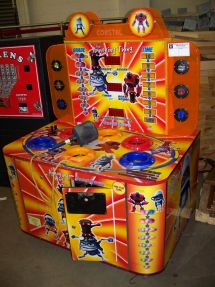More actions
m changed some stuff because i changed the name |
m IR gate |
||
| Line 7: | Line 7: | ||
==Technical Details== | ==Technical Details== | ||
Each target is actuated by a solenoid which raises them from their pocket. A sensor below the target detects whether it is raised or lowered. If a target is supposed to be raised, then gets lowered (by the player hitting it), the player is either rewarded or loses points depending on if Crazy Frog or the Drone is facing them. The rotation of the target is handled by a DC motor attached to the target by pulleys, and the rotation is determined based on two micro switches on either side of the target, with one being pressed depending on which side is facing out. | Each target is actuated by a solenoid which raises them from their pocket. A sensor below the target detects whether it is raised or lowered using what appears to be an infrared gate. If a target is supposed to be raised, then gets lowered (by the player hitting it), the player is either rewarded or loses points depending on if Crazy Frog or the Drone is facing them. The rotation of the target is handled by a DC motor attached to the target by pulleys, and the rotation is determined based on two micro switches on either side of the target, with one being pressed depending on which side is facing out. | ||
The game will still function as normal if there are targets that are broken. The operator's manual states that a switch is added in the coils to "prevent it from overheating and burning out." Targets that can't detect if they are raised or lowered will "pretend" to work, but actually hitting them neither scores nor subtracts points. The manual also adds that during the game, if a head is pressed or pulled on, it will still function. | The game will still function as normal if there are targets that are broken. The operator's manual states that a switch is added in the coils to "prevent it from overheating and burning out." Targets that can't detect if they are raised or lowered will "pretend" to work, but actually hitting them neither scores nor subtracts points. The manual also adds that during the game, if a head is pressed or pulled on, it will still function. | ||
Revision as of 21:09, 7 December 2021

The Annoying Thing is an officially licensed The Annoying Thing-themed Whac-a-Mole-style arcade game distributed by Coastal Amusements and manufactured by Feioli Electronic Co. The arcade machines were manufactured around 2006.
MeloNinja owns one of these cabinets. Its serial number is F24T-0125 and was manufactured in November 2006 in Taiwan (where Feioli is based in).
Gameplay
There are six targets which can rotate while down and inside its hole. The front of each target is shaped like Crazy Frog, with the back having a painted-on Drone. The player must whack the target when Crazy Frog is facing them to gain two points. If a player hits a Drone, two points are added to the "points deducted" score. Additionally, if a Crazy Frog isn't hit after a certain period of time, a "ding ding" sound is played, and one point is added to the "deducted" score. As the game is played, a short clip of Axel F is played from the speakers. At the end of the game, the deducted points are subtracted from the points earned, and if the player has enough points, they can move on to a "second level." This second level is like a bonus level where the targets move faster and the music plays faster. At the end of this bonus level, the final score is calculated, and the player is given a "grade" of diamonds, which determines how many tickets they will receive.
Technical Details
Each target is actuated by a solenoid which raises them from their pocket. A sensor below the target detects whether it is raised or lowered using what appears to be an infrared gate. If a target is supposed to be raised, then gets lowered (by the player hitting it), the player is either rewarded or loses points depending on if Crazy Frog or the Drone is facing them. The rotation of the target is handled by a DC motor attached to the target by pulleys, and the rotation is determined based on two micro switches on either side of the target, with one being pressed depending on which side is facing out.
The game will still function as normal if there are targets that are broken. The operator's manual states that a switch is added in the coils to "prevent it from overheating and burning out." Targets that can't detect if they are raised or lowered will "pretend" to work, but actually hitting them neither scores nor subtracts points. The manual also adds that during the game, if a head is pressed or pulled on, it will still function.
The operator of the cabinet may adjust various settings on the cabinet by adjusting DIP switches. These DIP switch settings include:
- Amount of coins required to start the game (from 1 to 4 coins)
- Length of the game (from 20 to 50 seconds)
- The score required to unlock the bonus second level (30 to 60 points or no bonus level)
- The length of the second level (10 to 20 seconds)
- The difficulty of the game (easy or difficult)
- The length of music played before the game starts (short or long)
- If tickets should be rewarded or not
- The number of tickets given per number of points earned (2pt/ticket up to 20pt/ticket)
- A number of "consolation tickets" given for playing (tickets given regardless of points earned) (0 to 12 tickets)
- Maximum ticket payout (16 to 20 tickets, or no limit)
Another setting the operator can set is the volume of the speakers, controller by a potentiometer on the speaker amplifier board above the main PCB.
Unless ticket payouts are disabled, the machine will not operate if there are no tickets in the dispenser, displaying error code "10" when booted up.
Locked behind the coin selectors are two buttons, "free play" and "test." The free play button bypasses the coin selectors and starts the game as if the player paid. The test button starts a sequence where the machine tests each of the six targets to ensure they rotate, raise, and detect hits properly. If one fails the test, an error code is flashed on the scoreboard until the machine is rebooted in the form of "X-Y"; X is the head number (from 1 to 6, starting from bottom left going counterclockwise) and Y is a number from 1 to 3:
- X-1: "GO UP SENSOR ABNORMAL" - the sensor that detects if a head is raised or lower isn't functioning properly.
- Either the coil is broken and the head won't raise at all, or if it does raise, then hits will not be detected from this head.
- X-2: "ROBOT SWITCH ABNORMAL" - the switch that detects if the target is rotated to show the robot isn't functioning properly.
- Either the rotation motor is broken or the switch is broken.
- X-3: "FROG SWITCH ABNORMAL" - same as 2 but for the other side.
All parts are operator replaceable, and a parts list is included in the operator's manual. Coastal or Feiloli may offer replacement parts to operators.
Gallery
-
Top of the unit.
-
Side of the unit.
-
Front of each target, broken off of the machine.
-
Back of each target.




